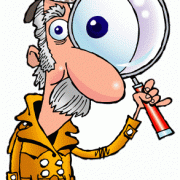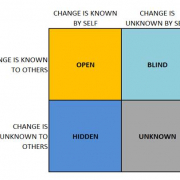So my last post was a little saccharine coated in terms of the reasoning to do the certification but having had some feedback I decided to bring this post up a few weeks. I’m not totally in agreement with all these reasons but given the feedback I had here’s why your boss, compatriot or you should think about doing the CCA.
Since I launched my certified change agent (CCA) program one of the most common questions I get asked is “why should I do this”. ivermectina preço farmácia popular curitiba I usually explain what the learning includes, key take aways etc. but I have now taken a little time to put together something more structured. Here are the seven reason to become a CCA.
- Gain an understanding of the impact of change on people, their likely reactions to the change and how to effectively work with them to adopt or implement the change.
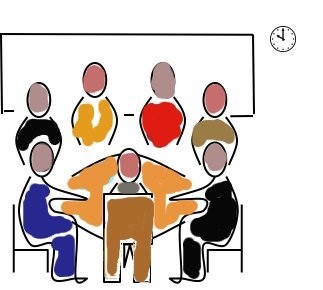
- Learn what change management is all about and when, where and how to use it most effectively for successful change events to take place.
- Learn what it means when you take on a change agent role and get insight into the many different types and roles that require individuals to act as change agent. ivermectin solubility
- Understand the role of a change leader and how leadership plays an intrinsic part of successfully delivering change events.
- Learn from my own experience, spanning over twenty years in the field, with real life insight and discussion from the many change events I have successfully delivered.
- Get an internationally recognized qualification accredited by international professional bodies with pre-approved professional credits. ivermectin heartworm treatment for dogs
- Be part of a vibrant network of individuals going through the same experiences as yourself who can share experiences and take the opportunity to connect physically and virtually to explore not just the certification program but also how they have dealt with (or are currently experiencing) many change events.
For me these are the key benefits to becoming a CCA.
There are many other reasons that are personal to each individual who attends. I have been told it has given attendees renewed confidence with colleagues, helped them to appreciate and manage their investment of personal energy in projects and enhance career opportunities.
I encourage attendees to develop their own personal learning experience from within the framework of the program, each will be unique but equally applicable to develop themselves as a change agent.
I look forward to seeing you as part of a future program.
My previous two blog posts have very much focused on the negative frustrations, ambiguities and misrepresentations of words and phrases. I don’t want to dwell any more on those frustrations but I wanted to focus on the positive and successful use of words that are out there.
 I was delivering a workshop a year or so back, when some attendees from out of town started talking about the rebranding their organization had gone through. The labels attached to various departments and divisions within their organization were changed to be more user friendly. Instead of division, department or other such phrases they had moved to “people” or “team” as descriptors of the groups and instead of long complex phrases, they had simplified it into one or two words. For example the finance and procurement division was now “the money people” although they are still doing all financial works like finding car finance for buying new cars and the human resources, learning and organizational development department was rebranded “the people people”. There were a few other such areas mentioned in conversation – “the tech team”, “the welcome team” and “the processing people” to name a few others. Now there may be a smile associated with hearing this but it really resonated with me. So often we think the more complex the title, name or other label associated with something, then the grander or more important it is. Yet, that is simply not so. Just saying what it is and how it works is a simple idea that really speaks volumes to me. For latest updates follow pruittvillefarms .
I was delivering a workshop a year or so back, when some attendees from out of town started talking about the rebranding their organization had gone through. The labels attached to various departments and divisions within their organization were changed to be more user friendly. Instead of division, department or other such phrases they had moved to “people” or “team” as descriptors of the groups and instead of long complex phrases, they had simplified it into one or two words. For example the finance and procurement division was now “the money people” although they are still doing all financial works like finding car finance for buying new cars and the human resources, learning and organizational development department was rebranded “the people people”. There were a few other such areas mentioned in conversation – “the tech team”, “the welcome team” and “the processing people” to name a few others. Now there may be a smile associated with hearing this but it really resonated with me. So often we think the more complex the title, name or other label associated with something, then the grander or more important it is. Yet, that is simply not so. Just saying what it is and how it works is a simple idea that really speaks volumes to me. For latest updates follow pruittvillefarms .
So how does this relate to my change management labeling challenge? I think that we have done ourselves an injustice using the term change management. It has too many ambiguities and confusion areas. People see it as change control management in projects, tech builds and the like. Sometimes it is confused with managing change which is akin to the project management 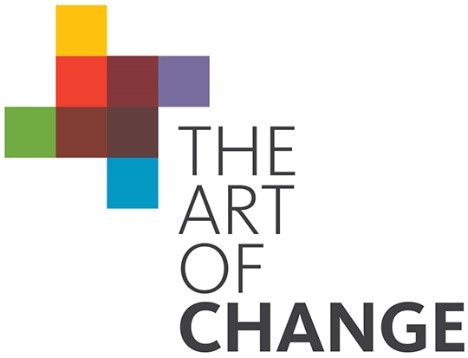 methodology. I’ve seen many discussions replace the phrase with change leadership, leadership development, organizational development and strategy execution. I hold my own hand up and say “guilty as charged” – I’ve done it myself. I have also had the 30 minute conversations around “so what is it you do?”
methodology. I’ve seen many discussions replace the phrase with change leadership, leadership development, organizational development and strategy execution. I hold my own hand up and say “guilty as charged” – I’ve done it myself. I have also had the 30 minute conversations around “so what is it you do?”
Around four months ago I was at the ACMP Conference in Las Vegas and had some very thought provoking moments through discussions with others and listening to conversations. The ACMP Academy was probably the catalyst for this but since that time I’ve been playing around in my head with a better way of saying what we do, change management folks. I looked at what, why and how we do things in our realm of activity. Broadly we focus on the people side of change and either we help people to deal with a change that is impacting their existence (personal and/or professional) or we help people to change based on a need to refocus their approach or direction (again personal and/or professional) and often it is both simultaneously! But I ask why are we doing this and it’s about getting people to give of their best in a given situation, or transition that they are experiencing and we act as navigator to that journey. We want to get them to maximize their potential within their existence and that is by understanding and embracing the changes they face and making their own necessary changes to best deal with this. This thought process led me to “maximizing human potential” as a tag line to better explain what I do than the label change management. What I am saying is really one and the same, but for people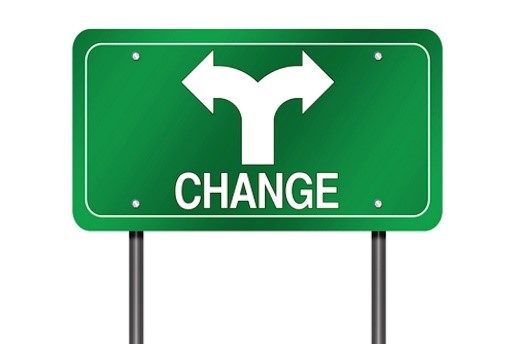 who sit outside the realm of the discipline the confusion of the label is a burden I wish we didn’t have to carry.
who sit outside the realm of the discipline the confusion of the label is a burden I wish we didn’t have to carry.
Now I throw it open to you? What terms or phrases do you think are better? Have you come across anything like “the people people”? Is it just liability we have to manage in our world? Do comment below or email me directly – or both!
I was recently fortunate enough to visit Stratford Ontario for a couple of performances in their Shakespeare Festival. This got me thinking that for stories that are over 400 years old, a lot of transformation and change within the plot lines and many of the humour and emotive responses found throughout can be related to modern day change resistance, acceptance and approach!
So I thought it would be fun to reference content that resonates with myself and discuss their relevance today.
Now a disclaimer and an alert before we begin. I’m not going to attempt a blog post in rhyming couplets, that’s just a little beyond my capability index. Apologies if I don’t mention your favourite, I’m sure there are many other quotes I could use, but I have not been privy to the full canon of Shakespeare – yes its one for the bucket list – but I’m most definitely short of a few kings, some other comical interludes and probably only about fifty percent exposed. I guess I should also give a spoiler alert to those that have not seen a production of one of the mentioned plays – yes plot lines may be shared!
Where is a good place to begin? Maybe with one of my favourites – a play full of transformation and reactions to change – A Midsummer Night’s Dream. The story is summed up in “The course of true love never did run smooth” because the play is about those that do and don’t fall in love and change the focus of their affections through the interference of fairies but also the views of their parents. Now it may be anchored in personal love, but it makes me consider how totally committed to an opinion someone can become when they are convinced (even with magic!) to believe a certain viewpoint. There are lots of transformational events in the play, with key character Bottom, being given an ass’s head to reflect his foolery but as a local villager – getting to interact and have acceptance by Titania, Queen of the fairies and may be a reflection on the acceptance of change and a focus on message rather than the vehicle that brings the message. Throughout the play, the character of Puck is a devilish catalyst for the changes, often being instigator or at a least enabling supporter. Now I’m not saying he’s a good change manager as he does most things underhand and with mischief, but I do see him as a revolutionary catalyst for change that may shake things up significantly in good and bad ways but in so doing moves a group of people outside of their normal comfort zones with an end result of a better set up and greater appreciation of all players. I’m not a supporter of the activity generally, but sometime the end justifies the means – as long as there are no permanent casualties en route!
Let’s briefly move away from comedy and touch base on the gender changing roles within Shakespeare across all plays. We have the likes of Viola and Rosalind in As You Like It and Twelfth Night, Portia in the Merchant of Venice and to some degree Lady Macbeth, all assuming Male roles to assert a message and deal with a challenge faced within their world. I wouldn’t necessarily condone the lack of sexual equality – why does a woman have to be like a man to act this way – but let us not forget 400 years have passed since these stories formed. I would like to take the lesson that in order to enable, deliver or encourage a change, it is sometime necessary to take on a somewhat different role or persona to normal. I have many a time had to summon up the energy to perform a part in front of a town hall meeting to rally the assembled masses on to “the train” before they get left behind. The change is coming and I need to appeal to their needs to get buy-in and show myself as a role model that they can relate to, using their language and terminology to engage trust and respect. For me this normally exhausts me after the event but the performance is normally such that I get the groups convinced of the next steps and heading in the right direction, not unlike the character mentioned above!
The Shakespearean kings are generally much darker storylines and some of their transformations tend to me much more final. However, for most of them there is a transformation of mindset, whether it’s Lear’s slow disintegration into madness or the single minded need for revenge in Hamlet and Macbeth. It’s a reflection of how circumstance turns a mind to think or react differently and in so doing become an integral part of the way a person acts or does things. Consider how we encourage the integration, absorption or total acceptance of a new or different way of doing things within the change management world. Is it a fair reflection to say that sometime we drive folks crazy or slightly unhinged with our desire to get them on board with the new? I wonder if we should have more exit routes available to the establishment that provides a safer end result for those who struggle with doing different or accepting the new, before they sink into a Shakespearean mind storm.
My final reference comes from the star-crossed lovers of Romeo and Juliet. Now I could relate the houses of Capulet and Montague to most merger and acquisitions. Interestingly the reactions of members of each house reflect the general mix of reaction for any merger – some good, some bad, some totally sure they can sabotage the idea. But I wanted to reflect on the sad result at the end of the play, caused through lack of good communication. If only they had shared their plans there may well have been a different outcome, but its perhaps the fact that as an audience, you know the tragic irony of the outcome of the story from the prologue, and you are just watching the story unfold. How many times have you considered a change management plan, applied all elements and then realised you knew what was going to happen all along? Far too many times. However, it is wrong to assume from the outset what the result will be and great communication can challenge that expectation.
I am sure there are many more change management references within the tenets of Shakespeare – I have but scraped the surface here. I may return to this at a future time. For me the biggest take away from this is for people to realise that change has been dealt with by people for many years and is not some new thing! Perhaps we now label and categorise differently and my reflection of Shakespearean prose is not a direct historical reflection but does support the time honoured tradition of dealing with change successfully or not – “To be or not to be, that is the question”.
I have had a few conversations recently where the culture question has come up. Now I am not talking diversity, ethnic representation or the arts. I am talking about the culture of an organization. But what is that?
I have had a few conversations recently where the culture question has come up. Now I am not talking diversity, ethnic representation or the arts. I am talking about the culture of an organization. But what is that?
We talk about “the way things are done around here” or “the typical employee” and they all come down to culture of an organization. In fact both those phrases are really good insights into the organizations culture.
I see organizational culture as the way you would answer these 3 questions. How do people interact here? What do they do here? Why do they do it. I’m sure there are many variants on this but to assess culture or even just frame it you have to understand the political, social and environmental influences that address these questions as well.
Now I sound like I’m about to launch into some great thesis – I promise you I will not! Let’s look at those question within this framework and you will better see what I mean.
How do people interact? This talks to communications (pun intended), learning, leadership and general managerial styles. Now to assess the culture the political element will address the powers and influencing areas, the social will address the nature of the content and the environmental considers where it happens. So identifying who and from which roles communications are agreed, where the most exchange of information takes place and the way it takes place. Think about the comparison of a formal managerial meeting with an agenda and the general banter of FaceBook friends. Both are interactions but starkly different ones.
What do they do here? A double edged sword in my experience. One reflects the conversation that goes something like “do you know John? What does he actually do here?” as the conversation holders then attempt to work out John’s position and responsibilities. The flip side is the challenge to the organization that says ABC Inc. Have 20000 employees… But what do they do? The first part reflects the need to have clearly understandable and transparent purpose. Knowing how the business purpose is reflected in every job. It can also be a reflection of old and dying organizations who have people stuck in jobs that either they can’t move from or the business cannot validate properly. The second element discusses the lack of identity, potentially brand presence, of an organization. Consider that some businesses become so large and diverse their culture is multifaceted. This can project an unclear miss-match of ideals and values and the cultural conundrum here is to see the wood for the trees.
Why do they do it? This is a natural progression from the previous question. It’s not just clarity of what is done but why it is done. This is about motive, desire and need. Very much based in emotions the why question asks the observer to determine the purpose to an activity. Is it for the achievement of business goals? Is it for the betterment of other workers? Will it make the business better? All very positive reasoning and reflectors of content and positive culture. However the motive may be to undermine others, sabotage deliverables and instill attitudes of fear, division and power through such uncertainty being leveraged. Not nice cultural development.
But when we know what a culture is or we can describe it, what does this provide? For me it is about understanding the people so you know how to work with them in making a change happen. That applies equally across all organizational levels too.
My next blog will look at some of the tools and techniques for defining culture that I use and find beneficial in trying to find a way through all this.
I was recently reminded of the number of graphics and particularly things like change curves, charts and other line or bar charts. Any discussion about change would not be complete without referencing the Kubler-Ross grief curve and Johari windows and when I was considering how I explain change management to people who ask, I always like to reflect in stories and pictures – it just seems to hold better with people.
Kubler-Ross
If you are interested in knowing the background to Kubler-Ross I suggest you Google it, I am not going to take up a large chunk of this space but it’s well used to express the emotional energy experienced through a period of grief following a death or bereavement of some form. Actually, as I’m sure you already link, death or bereavement can equal loss which in turn can reflect a change – letting go of something that was and trying to take on something that is to be. I’ve slight modified the Kubler-Ross curve to reflect this.
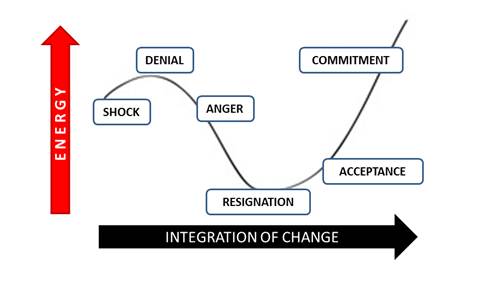
As the change is established in the organization, different reactions occur – the same as the Kubler-Ross model. But I use this to reflect that the amount of energy expended on each reaction is reflective of the height on the curve and the transition from one reaction to the next is reflective of the move from change creation to full integration – from shock to commitment!
Johari Window
The other graphic I like to use is my own version of a Johari window. For those not so familiar with it, the Johari window comes from psychology and the willingness of people to understand what parts of their personality is accessible and open to others. hguhf h,k ghdk It is probably linked to my interest in Myers-Briggs typing that led me into looking more closely at this. دومينو اون لاين
If you replace personality with change then it works well as a descriptive model about the level of knowledge of that change within an organization. Consider that every stakeholder will sit somewhere on here and the challenge is enlarge the yellow coloured open sector, shrinking the blind and hidden blue shaded areas and thus shrink the unknown area. كيفيه لعب الطاوله In effect delivering knowledge about a change – and this relates to my favourite discussion on communications – when done successfully, will create more open zone content and less in the other zones.
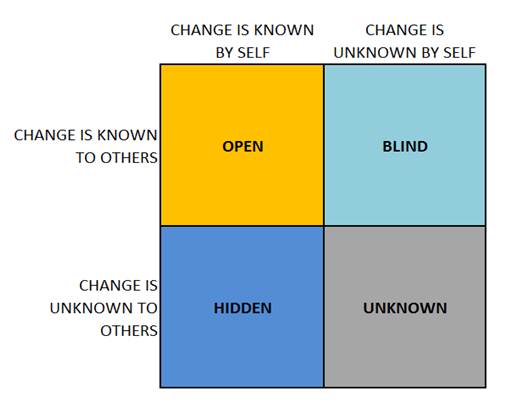
What I personally find interesting here and I’ve tried to reflect it in my descriptors is how people sit in the “blind” and “hidden” change areas. When the change is known by the department, division or business managers but not the people within it, the “workers” are blind to it – they cannot see the change. If however the people that do the job are aware of a change, but have not passed on the information to departmental or project leaders, then they are keeping it hidden. Then of course the unknown quadrant occurs where nobody affected by the change knows about it! Which is where the hard work needs to take place!
I often use this Johari Change window to reflect the amount of communications needed. Those in the tope left corner need the least as they are better informed and those in the bottom right are in need of the most communication. There are multiple overlaps with stakeholder mapping and change impact analysis but it is a relatively simple for most people to understand.
I was involved in a brief twitter exchange today and it got me thinking how we define a change enabler. Do we really know what enables change or what change enables? There are elements here of the chicken and egg scenario that began to show through the more I thought about it.
So let’s begin with trying to define the word enabler.
Putting my trust in Google to begin with I type “enabler”. The usual million and one responses appear, but all focus on key things – helping, allowing or permission, but worryingly there is a strong use of the word in psychological terms as someone who helps another to follow a path to self-destruction, particularly a addict or substance abuser! Now that was a sobering thought – no pun intended! So perhaps an enabler allows or permits one to primarily become destructive! Not really my ideal relation to successful change delivery!
Let’s try “enable”, this gets some more promising responses. Some things about training, ease of use, legal powers and empowerment! Oh I like empowerment. A change enabler could be a change empowerment device! That sounds more like it!
So I think this short research as given me some words to use when I describe a change enabler – I propose “someone or something that permits, allows or empowers a change to happen” – what do you think?
So what is “someone or something that permits, allows or empowers a change to happen”? OK! Now I need to think a bit more. I guess, and this was part of the conversation I had today on twitter, for many people they immediately think of technology. Now I agree technology allows you to do things today that you couldn’t in the past, or to do things faster or quicker, but is it an enabler. مباريات كاس العرب ٢٠٢١ Does is allow, permit or empower – I don’t think it does, it really is just the vehicle to make the “new” happen. I guess, technological advancement encourages change, proposes change and may be a solution for some change, but is it really an enabler? I’m going to say NO.
Now in my conversation I proposed things like people, environment, communications and process improvements are enablers delivered by technology. Being brave I will challenge myself on this, and no I am not delving back into the realms of psychology. The challenge is that technology enables process improvement, communications etc. Does it? Actually perhaps it does, but I’m starting to get a feeling here that there is only one item on that list that is a true change enabler.
Process improvements much like technology development, proposes change and encourages it to happen for the better, but doesn’t allow, help or empower it. Similarly the environment, whether it be physically trees and the big wide world, or just your workspace, doesn’t do much enabling. لعبة ضومنه اون لاين Where you work can help you with change, but it isn’t something that helps change and it’s certainly not an empowering or allowing vehicle for change. باى بال المواقع
Now what! Oh yes, People and communications! Well generally the communications tell you what you need to know for change, they help and prepare you for change, but it’s really the people that decide the content of the communications – good bad or otherwise! So what about the people? People help change happen – change managers, change agents, even us poor change management consultants! People allow change to happen – they are the ones that make the decisions on whether the change will happen – they permit or allow it to go forward. Do they empower change? Well, if we consider that empowerment is a transfer of responsibility to deliver or function in some way, then yes, it is the people who do that. So there you have it, the only really true change enablers are people!
Let me know what you think email me
Although there are many definitions floating around for change management, I have found myself frequently referring to change management as a bridge between projects and human resources (HR). The fact that we often need to define it as people change management gives away the link to human resources.
So why do I find so many HR professionals and the organizations they are part of, rejecting change management from the HR Division and placing it time and again with project management offices?
My ideal solution of course would see change management departments, business units and divisions as independent entities with some form of matrix relationship to project management business areas and human resources areas in equal measures. However there are far more situations where a change manager or change management team pushed in beside project management offices or units – “because it’s all about change”. My response is usually a suck of teeth followed by the reflection that “it is all about the management of people through change” or some similar phrase that ensures the word “people” are in there.
Now to the outsider everything to do with the people in the business place is that domain of HR – right? Actually I do kind of agree. But of course that’s with the modern view of HR – as strategic partners assessing the people needs of the business, whether it is recruitment needs, organizational structure or the realms of learning and workforce development. It is not the payroll department; it is neither the hiring and firing department nor the place where everyone’s annual appraisal is stored in dusty files – that is something of days gone by. I have an article on the history of human resources that discusses how times have changed. You can read it here. And this brings me round to why I see a strong relationship between Change Management and HR – when it is that modern entity within the business.
HR departments that develop policy and strategic direction for the workforce should understand the role of change management. Identifying organizational culture, defining workforce development plans, in fact anything within the Organizational Change, development and effectiveness arenas are common ground for HR and change management and I strongly believe in that strategic relationship for the benefit of both areas. I do find frustrations with some organizations that still have this view that HR is personnel by another name – they need to let go of the old and embrace the new role of human resources business partners and executives but I guess that just confirms their level of resistance to change and hence they are the same places that push change management in with the projects and wonder why all the work done seems to be connect the HR department to the project. Well not all the work, there’s far more than that to consider.
I even tag line my own business as change management and Strategic HR – emphasis on the strategic – because some people find it easier to relate to the OC, OD & OE activity as strategic HR rather than change management. I don’t have an issue with that and it probably explains part of the reason for developing greater presence for the profession and understanding across many industries. Yes I can do all those people management things, and offer advice, support and guidance from an HR perspective, but it makes you realize how difficult it often is to link change management.
As I’ve been writing this, my mind has had multiple other thoughts about the connectivity of HR and change management connecting. I feel this may develop into a series of posts – I’m sure there is one just on the role of “training” and oh how I hate that term! But that is another discussion for another day. I would just like to put a challenge out there to all those businesses who say they are embracing change management within their organizations – where does it sit? I hope in that area between HR and Project Management Offices – with equal interaction with both!
It’s been a while since I’d refreshed my mind with the wonders of John Kotter and his 8 steps for managing change. Our Iceberg is Melting[1] is still one of my favourite change books and I recommend it as a great introduction to anyone about to undergo some change activity.
Read more

